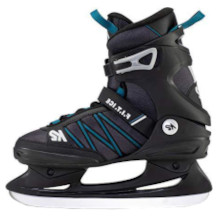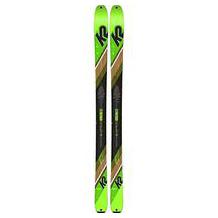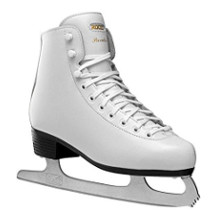Sled purchasing advice: how to choose the right product
- What you need to know
- Sleds are usually made from wood or plastic.
- There’s a big range of plastic sleds, from simple saucers through to jet-ski style toboggans.
- Most wooden sleds are either Davos style or horned.
- Different sleds perform better or worse depending on how thick and hard the snow is.
Fun, sport, transport
When there’s a lot of snow, you can’t do without a sled. Wheels don’t work on snowy or icy surfaces, so having a sled as a transport option can be a life saver. Since there’s not much friction with the ice, you can pull a heavy load without much effort, like how Inuit use sledges for transport over massive distances.
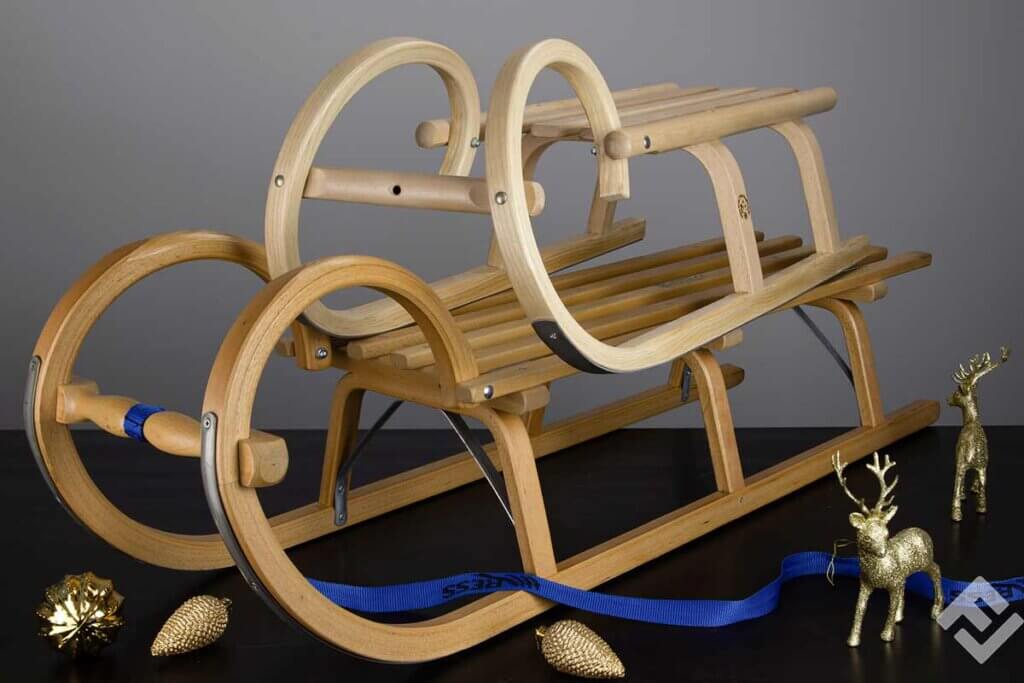
Sled construction
Since there’s such a varied range of sleds on the market it can get a bit tricky when making some general statements about how they are constructed. The most basic sled designs aren’t much more than a plastic disk that you sit on, but this simplicity reveals the features common to all sleds: they have a seat and a surface which comes into contact with the snow.
Classic wood or light plastic?
Recreational sleds are generally made from either wood or plastic and can have metal parts – for example on the runners.
Wood
Wood is the classic sled material. Strong and durable, this eco-friendly material makes for a vintage sled aesthetic – Santa has a wooden sled after all! Wooden sleds aren’t suitable for all kinds of snow, as they usually weigh more than plastic ones. Another thing to consider is that you have to store them properly because they can’t withstand being left outside in extreme weather for a long time.
Advantages
- Classic aesthetic
- Environmentally friendly
- Durable
- Robust
Disadvantages
- Heavy
- Not suitable for all kinds of snow
- Needs to be stored properly
Plastic
Plastic is used for modern sleds which are usually lighter and faster than their wooden cousins. This means they’re easier to transport and can be more fun when whizzing downhill. Some plastic sled models even have steering wheels! These aren’t the only reasons why they’re so popular: they are also much cheaper than wooden sleds. This being said, plastic is much less durable and strong than wood. Plastic sleds generally have far shorter lifespans than wood – sledding isn’t the softest activity and the brittle plastic can break if you ride over something unwanted. Another thing to consider is that plastic is extremely harmful for the environment, both when it is being produced and if it isn’t recycled.
Advantages
- Light
- Fast
- Cheap
- Often fitted with a steering wheel
Disadvantages
- Not very durable
- Don’t last very long
- Environmentally damaging
The most important sled designs
Nowadays sleds come in a lot of different shapes and sizes. In fact, the meaning of the word “sled” has become so broad that lots of the products on the market barely resemble each other. You can still buy the classic wood style, but there are also saucers and even blow-up models which are more reminiscent of swimming pool inflatables and summer than winter sledding.
Wooden sleds
Wooden sleds are mostly either Davos style or horned designs. Both types are pretty similar – in short, horned sleds are basically just Davos sleds with two handles to hold on to. On most models you’ll either sit on slats or belts. Contact to the ground is via two runners, usually made with metal, which curve upwards at the front.
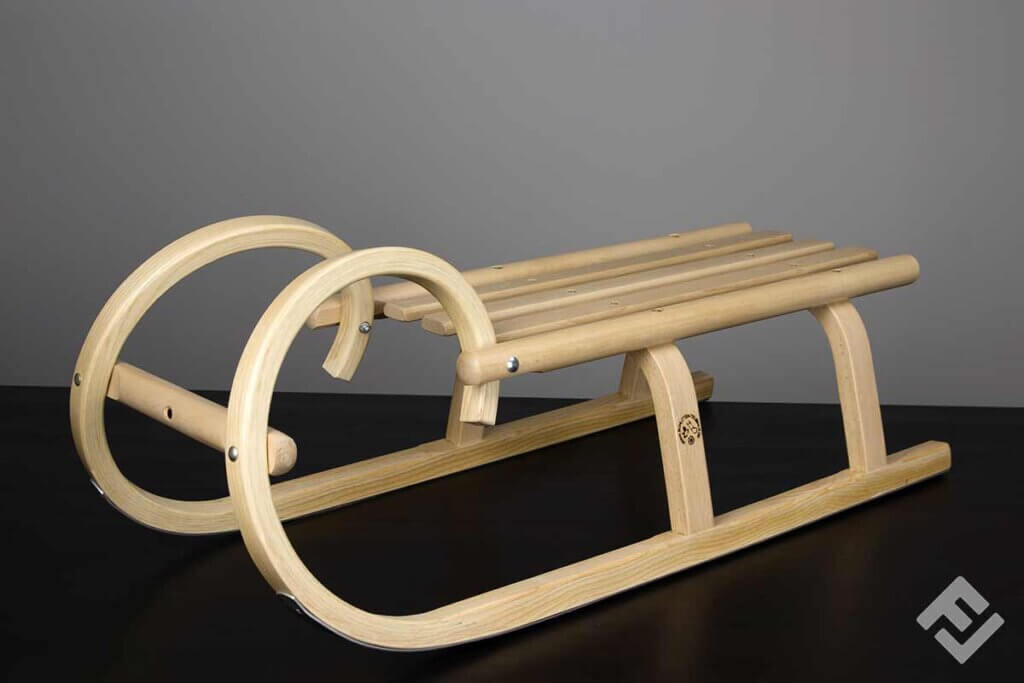
A lot of people really love the vintage aesthetic you get with wooden sleds because they fit with the ideal winter image. It also helps that they are durable and long-lasting! Normally they have enough space for two people and can carry the most weight compared to other sled types. The parallel runners mean you’ll move forwards in a straight direction – you’ll barely need to do anything if you want to move straight forward. Steering is only possible by shifting your body weight or with your feet. Wooden sleds can go quite fast but carrying them back uphill can be a bit tiring since they are relatively heavy.
Advantages
- Vintage design
- Strong
- Durable
- Fast
- Directional stability
Disadvantages
- Steering is a bit limited
- Heavy
Plastic sleds
Plastic sleds come in lots of different designs. Many have brakes fitted on the sides. The simplest models aren’t much more than plastic tubs, but others can get quite complex. Some look like wooden Davos style sleds but made from plastic. Others have skis, a seat, and a steering wheel – you might think of them as snow jet-skis!
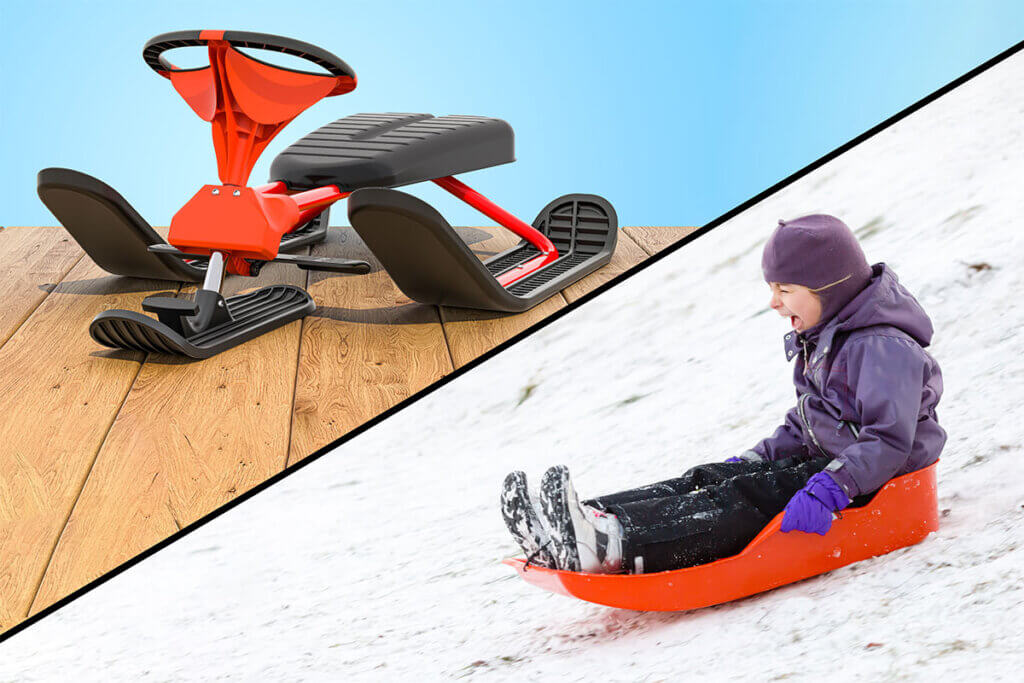
Depending on the model, plastic sleds vary a lot in weight and in how many people can ride them at the same time. Most sleds are designed for one person and are a lot lighter than wooden sleds. This lightness means that even sleds without steering wheels are easy to control. In general, they are the fastest kind of sleds – after all, Olympic bobsleds are a kind of plastic sled. The flipside to all of this is that they aren’t particularly durable.
Advantages
- Very fast
- Usually lightweight
- Simple to steer
Disadvantages
- Not very durable
Saucers
Saucers are the smallest kind of sled. They have a surface for one person to sit on, and some handles either on the sides or in between where your legs go.
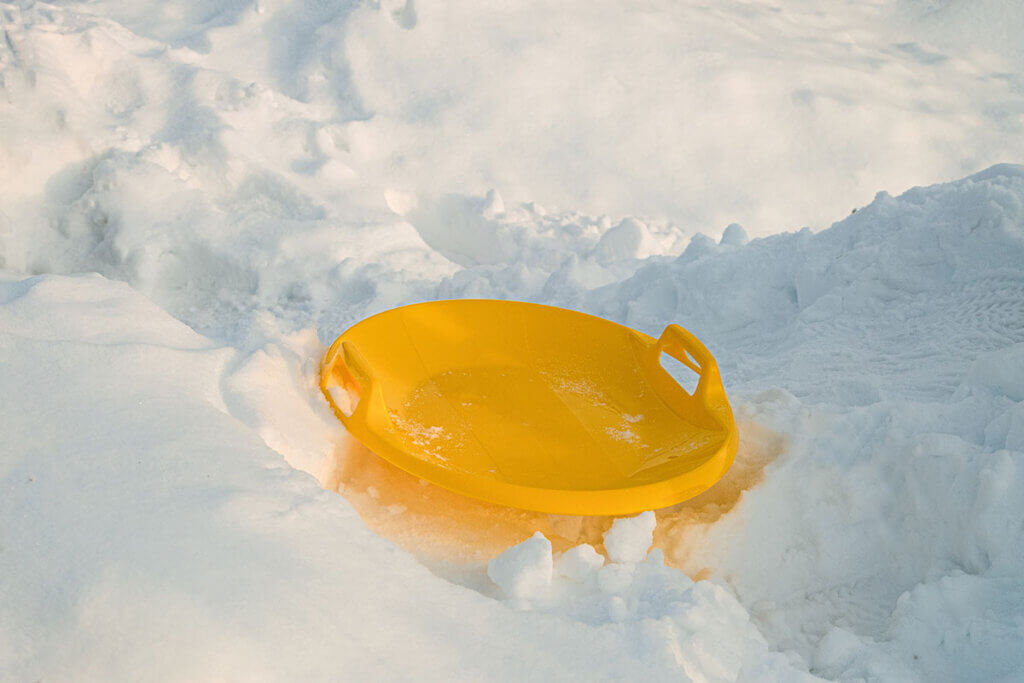
Saucers aren’t just light and small – they are also very cheap. If you’ve ever gone sledding with a plastic bag, you’ll find that saucers feel quite similar. The big difference is that saucers are of course much thicker than plastic bags. Nevertheless, saucers aren’t the most comfortable, to be polite. They don’t have any padding or any separation between the seat and the ground, so you’ll feel every bump and jolt as if you were just sitting directly on the floor. If you ride over rocks, you’ll know about it! Another thing to consider is that they are difficult to steer.
Advantages
- Light
- Very cheap
Disadvantages
- No shock absorption
- Difficult to control
Inflatable sleds
Visually, inflatable sleds are practically indistinguishable from pool donuts or tyres. Although inflatable sleds come in other shapes, such as surfboards or jet skis, they are usually ring-shaped. There are a lot of models on the market with fun, eye-catching colours and designs, which are great for kids.
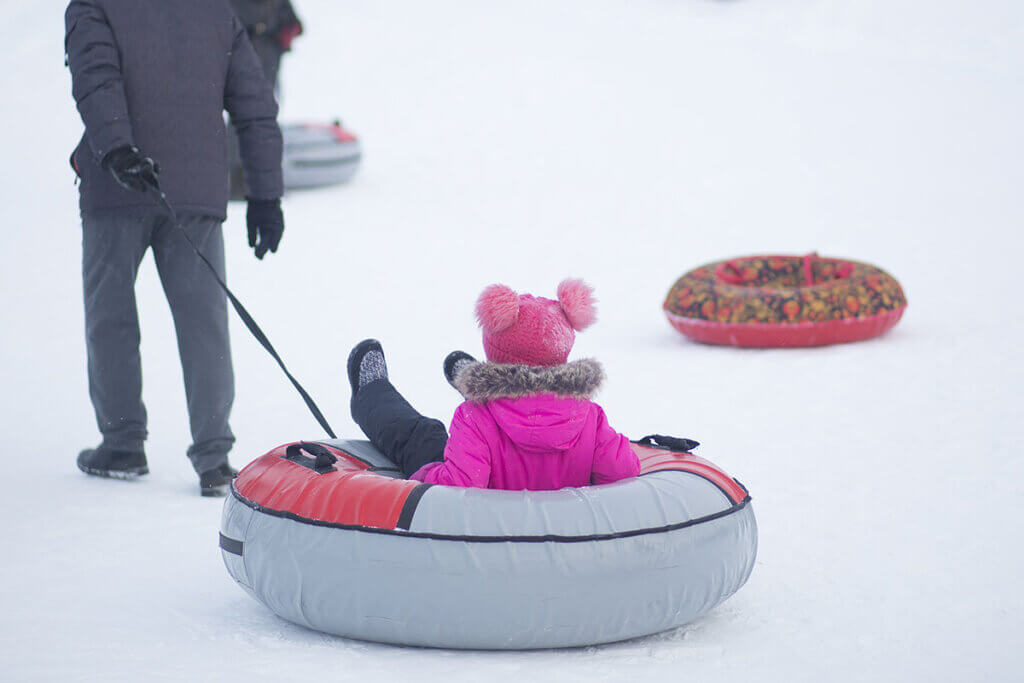
Inflatable sleds are light, space-saving, and easy to transport. They are also generally cheaper than wooden sleds and some plastic ones. You’ll have to blow them up before you get going though, and they do tend to lose air whilst sledding which makes them slower. It’s rare to find an inflatable sled that is suited for more than one person at a time. They are also very hard to steer – sometimes they can even start spinning as you go downhill! Inflatable sleds aren’t especially durable either – they can pop if you ride over something too hard and angular. If the plastic gets ripped, then you’ll have to get a new one.
Advantages
- Light
- Space-savers
- Cheap
Disadvantages
- Easy to damage
- Need to be inflated
- Not the fastest
- Difficult to control
Sleds for babies
Sleds for babies are usually made from wood or plastic and come in a variety of designs. What makes them special is that they have a secure seat with straps or a harness to keep your little ones safe. After all, babies and toddlers don’t have the best sense of balance and you don’t want any accidents to happen. Some models also have an integrated sleeping bag to prevent your child from getting too cold.
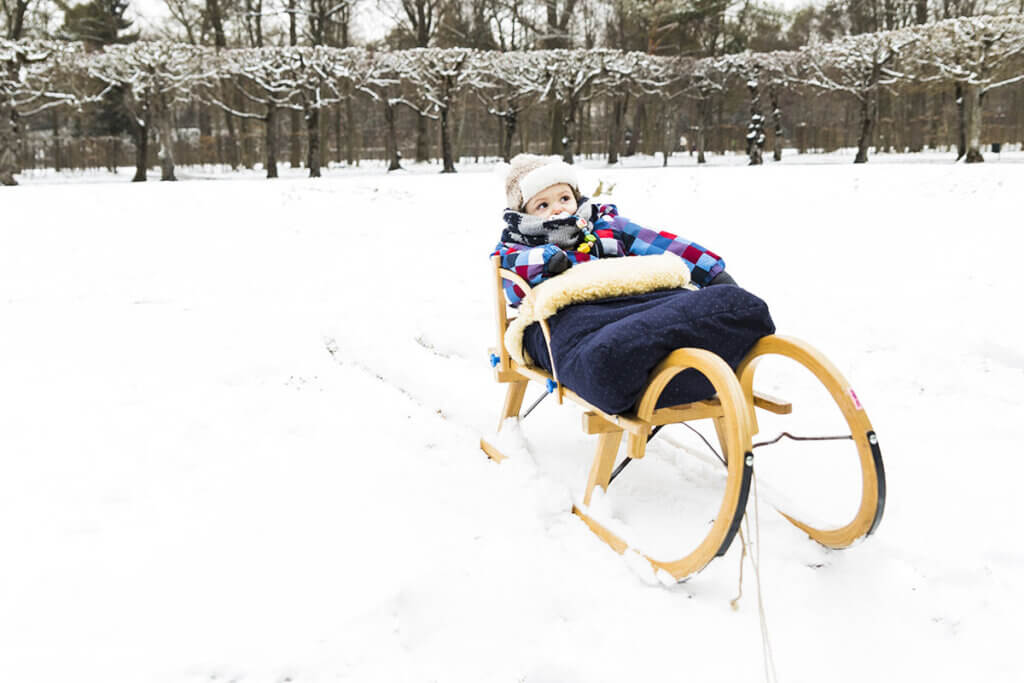
Comfort and security are the name of the game when it comes to these sleds. As a result, they are usually heavy and robust. Some models have removable seats which means they convert into standard wooden sleds – great for when your kids are a bit older, so you don’t have to buy a sled again.
Advantages
- Secure
- Comfortable
- Stable
- Robust
Disadvantages
- Heavy
- Usually just suitable for babies and toddlers
Snow matters
The kind of snow you’re going to be sledding on has a massive effect on what kind of sled will work best. Fresh white powder is very different to older hardened snow.
If the snow layer is thin but you still want to go sledding, then an inflatable sled works well. They are light and have a large surface area which means you won’t sink through to the ground. The thing to watch out for is stones and other objects which can spoil your fun by popping your sled. A heavy wooden or plastic sled will just sink through, and nobody wants to sled on muddy grass. A simple saucer sled is a good option for thin snow, but just like with the inflatable sleds, watch out for stones!
Wooden and plastic sleds need snow that is a bit harder. They work best on stronger and more stable snow surfaces, so you’ll have to wait a few days for fresh snow to freeze and harden.
Fresh snow is generally not for sledding because it is too soft. Heavy sleds with runners or skis will just sink in. If you do want to sled in fresh snow, then a light plastic sled with a large surface area is best because you won’t sink in as much. Once a few people have gone over fresh snow though it will get compacted, so you’ll be able to use whatever sled you have.
More purchasing advice
There isn’t much point in thinking about accessories and extra equipment until you’ve worked out what kind of sled you want. Each material and design style has its own features which can help you work out what you need.
Carrying capacity
Plastic sleds can generally carry between 50 and 100kg (110 to 220 lb) – roughly the weight of two kids or one adult. Wooden sleds are a bit stronger and can carry up to 130kg (286 lb). Inflatable sleds have the lowest carrying capacity – the more weight you put on them, the faster they will deflate. Since saucers sit directly on the ground their carrying capacity is determined by the surface area you can sit on.
Size and weight
Plastic, wooden, and inflatable sleds are usually between 80 and 130cm long (2’7”-4’3”). Saucers are much smaller and weigh around 1kg (2.2 lb). The other sled types can weigh between 2 and 7kg (4-15 lb).
Sliding surface
The sliding surface has a big effect on how the sled feels and handles. Wooden sleds and some plastic ones sit on runners or skis, whereas others like toboggans and saucers have a wide sliding surface.
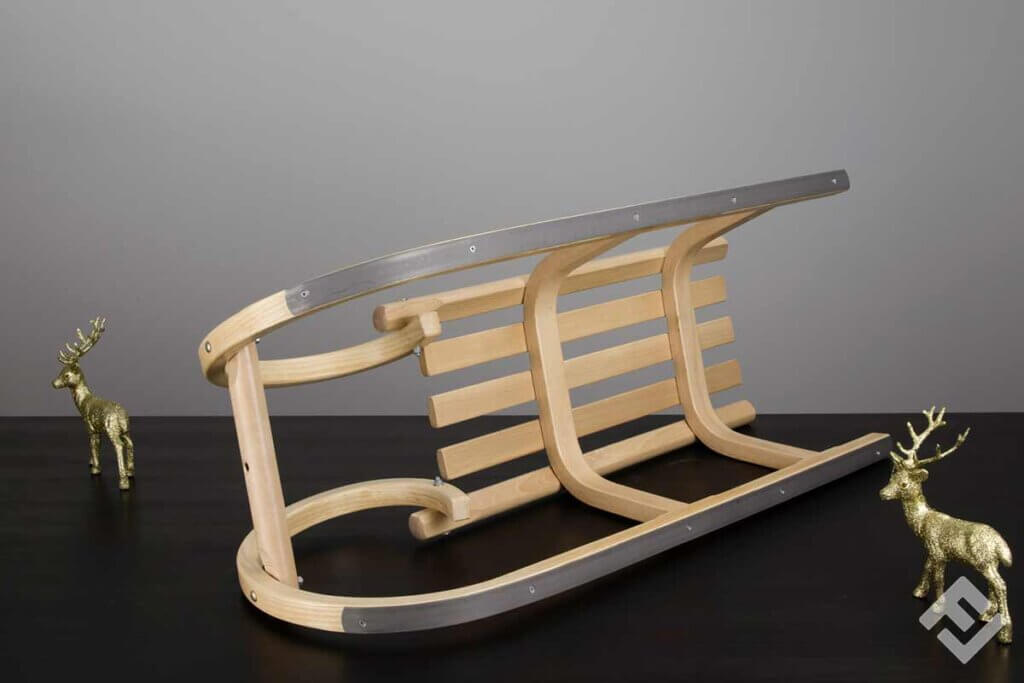
Comfort
The kind of material you’re going to sit on plays a huge role in determining how comfortable the sled will be. Wooden slats are quite hard and uncomfortable, so some wooden sleds will use belts for the seat instead. Plastic is softer than wood, but since most plastic sleds don’t have any padding, they are usually pretty uncomfortable too. Inflatable sleds on the other hand are very comfortable as they have a bit of give. On the other end of the spectrum, bum slider saucers make you feel like you’re just sitting right on the ground. If you’re riding on old, hardened snow or over stones, things can get quite sore.
Steering and braking
Sleds aren’t always easy to control. In order to steer them, you have to shift your body weight from side to side. Some manufacturers get around this by adding steering wheels, but you’ll only find them on some plastic models. These steering wheels often aren’t very effective, so it’s a good idea to use your body weight even if you have a sled with one. Using the tow rope on your sled to shift your body weight can also work well. In general, if you need to brake when going downhill on your sled, you will have to use your feet. Some plastic sleds do have integrated brakes. However, just like with the steering wheels, they aren’t very powerful so you’re best off using them in combination with your feet.
The latest sled innovation
Scooter sleds are the latest invention to hit the market. They look just like scooters, but instead of wheels they have mini skis – some models even have the option of swapping from wheels to skis! To ride them you’ll need a fair amount of balance and control, so they’re best for older kids or adults.
Useful accessories
The most important accessory for your sled is to have a tow rope or cord. After you’ve ridden downhill, you’ll of course have to walk back up – having a rope to drag your sled behind you makes this a bit easier.
Backrests and foot muffs aren’t necessary at all but sitting comfortably and having warm feet is always a positive!
Images 1-2: © FinalCheck | Image 3: © alexlmx / adobe.stock.com and © Mikkel Bigandt / adobe.stock.com | Image 4: © nskyr2 / adobe.stock.com | Image 5: © Александр Поташев / adobe.stock.com | Image 6: © ihorga / adobe.stock.com | Image 7: © FinalCheck

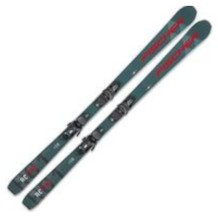
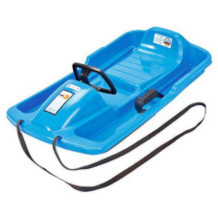
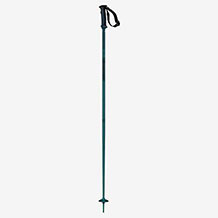

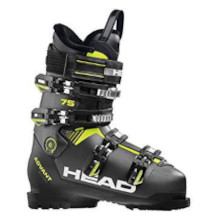
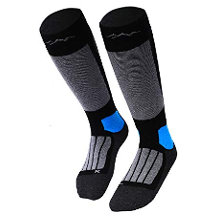
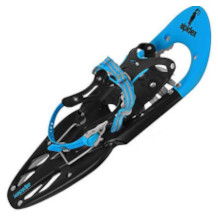










 138 reviews
138 reviews
